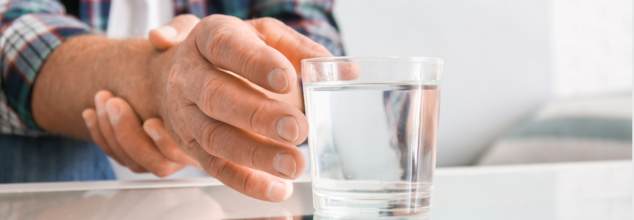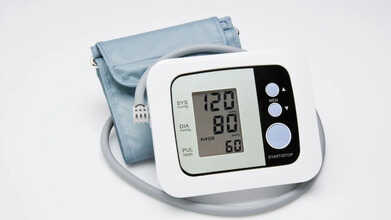- Health Conditions A-Z
- Health & Wellness
- Nutrition
- Fitness
- Health News
- Ayurveda
- Videos
- Medicine A-Z
- Parenting
- Web Stories
Parkinson's Disease Vs Essential Tremor: Clear Signs You Might Be Missing

Credits: Canva
Shaky hands, trembling arms, and uncontrollable movements—these symptoms tend to often trigger and suspicion of Parkinson's disease. But while Parkinson's is a recognized neurodegenerative disorder, another condition can be responsible for the tremors- Essential Tremor (ET). Although both share some superficial similarities, these two disorders are very different in cause, course, and treatment. And yet, many people struggle with misdiagnosis, delayed treatment, and unnecessary anxiety because of the overlap between them.
With greater awareness and understanding emerging, knowing how to identify differences between Parkinson's disease and essential tremor is more crucial than ever—more important to both patients, families, and doctors. Below's what you have to know about distinguishing between the two and doing something if needed.
What Is Essential Tremor?
Essential tremor is a neurological movement disorder that most often occurs in the hands, but it can affect the head, voice, or legs. Essential tremor is not life-threatening but can interfere with daily activities such as eating, writing, or holding objects, particularly as the disease advances.
It generally appears after age 40, but can arise at any time. The reason is not exactly known, though there is a strong genetic link, with up to 70% of patients having inherited it. Unlike with Parkinson's, ET gets worse with activity rather than rest, and symptoms are worsened by stress, exhaustion, caffeine, and even a change in temperature.
Symptoms include:
- Development of hand tremors gradually, usually beginning on one side
- Shaking that worsens with activity (e.g., drinking, writing)
- Difficulty with fine motor function
In a few instances, involuntary head nodding or voice shaking
What Is Parkinson's Disease?
Parkinson's disease is a chronic neurological disorder that impacts movement and gets worse over time. It happens when dopamine-producing cells in the brain's substantia nigra start to break down, interfering with the brain's ability to manage movement and coordination.
Parkinson's usually starts after the age of 60, although 5–10% of patients start earlier. In contrast to essential tremor, Parkinson's tremors are more prominent at rest and are just one of numerous motor and non-motor signs.
Main symptoms are:
- Resting tremors in hands, legs, jaw, or head
- Muscle stiffness and rigidity
- Slowness of movement (bradykinesia)
- Difficulty with balance and coordination
- Changes in speech and handwriting
- Depression, memory loss, fatigue, and sleep disturbances
Parkinson's vs. Essential Tremor: Essential Differences
While they might appear to be the same, essential tremor and Parkinson's disease are very different in etiology, presentation, and course. Here's a comparison:
Prevalence: Essential tremor is much more prevalent, occurring in as many as 10 million Americans, whereas Parkinson's occurs in about 1 million.
Tremor Type: ET is defined by high-frequency, low-amplitude tremors that are exacerbated by movement. Parkinson's is defined by low-frequency, high-amplitude tremors that are more evident at rest.
Symptom Onset: Symptoms in essential tremor tend to begin slowly and symmetrically, usually in the hands. Tremors in Parkinson's usually begin on one side of the body.
Alcohol Response: Interestingly, ET symptoms will sometimes improve temporarily with alcohol, but this is not a therapy. Parkinson's symptoms do not typically respond to alcohol.
Associated Symptoms: Parkinson's involves a broader variety of symptoms, including stiffness of the muscles, walking difficulties, and changes in the cognition that are generally not seen in ET.
Diagnosing the Difference
Since both diseases can start subtly and present with similar symptoms, diagnosis is frequently difficult. Physicians rely on neurological examinations, review of the medical history, and in some cases, brain imaging to make the differentiation between the two.
Regrettably, there isn't a test that can absolutely diagnose Parkinson's disease or essential tremor. They are frequently misdiagnosed, especially at early stages, and thus improperly treated or given delayed appropriate care.
Complicating matters further, there are some other neurological disorders that closely resemble Parkinson's disease, making diagnoses even more difficult. These include:
Multiple System Atrophy (MSA): Poor coordination and slurred speech
Lewy Body Dementia: Merges movement symptoms with memory loss and hallucinations
Progressive Supranuclear Palsy (PSP): Disrupts eye movement and balance
Corticobasal Degeneration (CBD): Increases in severity on one side of the body, includes speech and swallowing problems
Each disorder needs a distinctive treatment strategy, which underscores the value of proper diagnosis.
Who Is Most Susceptible to Developing These Condition?
Parkinson's disease is more frequently diagnosed in men, and the risk becomes much higher after 60 years. Most cases are sporadic, but in some, a genetic tendency is observed, particularly among persons with a history of the condition in their family. Environmental factors like long-term exposure to certain toxins and pesticides have also been shown to increase the risk of Parkinson's disease.
Essential tremor, however, can arise at any age but usually starts beyond the age of 40. It is highly hereditary, and approximately 50–70% of patients report a family history. Unlike in Parkinson's disease, there are no identified environmental triggers for essential tremor to date.
When to Seek Help?
Essential tremor is in most cases mild and controllable, but any worsening or disrupting tremor must be assessed by a neurologist. Treatment of both conditions involves medication, physical therapy, and sometimes deep brain stimulation (DBS). Early diagnosis, lifestyle changes, and professional help can significantly enhance the quality of life.
If you're having tremors, don't try to diagnose yourself or search online. Instead, see a neurologist who can steer you in the direction of the correct diagnosis and individualized treatment plan.
Parkinson's disease and essential tremor can have overlapping symptoms, but they are two different conditions with different causes, courses, and treatments. Understanding the differences—and getting timely medical guidance—can help people take charge of their health.
In a world where small symptoms can be misinterpreted, clarity is key. Whether it’s a slight hand tremor or noticeable movement change, paying attention to your body and getting the right diagnosis can make all the difference.
Wellness Report: 1 In 10 Employees Sleep-Deprived, Young Workforce Faces Rising Health Risks

Credits: Canva
In today’s hyper-connected, always-on work culture, long hours and erratic shifts are quietly eating into one of the most essential pillars of health.. A new study by Truworth Wellness, India Workplace Wellbeing Report 2025: From Access to Outcomes, reveals how sleep deprivation, chronic diseases, and poor preventive care are undermining employees during their prime working years.
Sleep Deprivation: A Silent Productivity KillerThe report, based on health data from over 46,000 employees across industries, found that nearly 1 in 10 workers suffer from sleep disorders, most of them between ages 23 and 39. This lack of rest translates to 11.3 lost workdays per employee every year, costing companies an estimated ₹2.1 lakh annually, as per the study.
Chronic Conditions Striking Earlier
Cardiac issues, diabetes, and thyroid disorders are no longer diseases of old age. They are increasingly showing up in employees under 40, adding long-term pressure on both workers’ health and company healthcare costs.Obesity and the Prevention Gap
Obesity is emerging as a ‘gateway’ condition, with 14% of employees obese, 71% of them in the 25–35 age bracket. Despite being the most vulnerable, younger employees are also least likely to undergo preventive screenings, delaying early detection of high-risk conditions.Poor Sleep Is Leading To Poor Mental Health
The report also warns of the mental health toll of sleeplessness. Chronic fatigue, stress, and unmanaged conditions fuel declining resilience and rising emotional distress at work. As Rajesh Mundra, Founder and Executive Chairman of Truworth Wellness, notes, “Wellness can no longer be a checkbox activity, it must be embedded as a strategic business priority.”ALSO READ: High, Low, or Normal? A Simple Guide To Understanding Blood Pressure Readings
How Companies Can RespondTo tackle the crisis, the World Health Organization (WHO) recommends:
- Training managers to recognize and respond to emotional distress.
- Mental health literacy programs to reduce stigma and raise awareness.
- Stress management and lifestyle interventions such as physical activity and psychosocial support.
The Business Case for Better Sleep
Companies that invest in outcome-driven wellness programs already see 28% fewer sick leaves, 26% lower healthcare costs, and 11% higher revenue per employee. For every rupee spent, organizations save ₹289 in healthcare costs and ₹241 through reduced absenteeism.A Wake-Up Call for Corporate Industries
As sleep deprivation silently chips away at productivity, Indian businesses have an opportunity to treat wellness not as an add-on but as a strategic advantage. By tackling sleep, stress, and preventive care, organizations can build healthier, more resilient, and ultimately more productive workplaces.ALSO READ: Prediabetes: How To Spot the Silent Warning Signs Before It Turns Into Type-2 Diabetes
By moving beyond generic wellness programs and focusing on measurable outcomes, Indian organizations can turn employee health into a strategic advantage. Embedding sleep, stress management, and preventive care into workplace wellness not only improves productivity but also builds a resilient workforce. The Truworth Wellness India Workplace Wellbeing Report 2025, conducted in collaboration with People Matters, highlights these insights and provides a roadmap for companies to act before small health risks escalate into costly chronic conditions.
High, Low, or Normal? A Simple Guide To Understanding Blood Pressure Readings

Credits: Canva
Half of all American adults have high blood pressure, also called hypertension, yet many don’t even know it. High blood pressure occurs when blood flows through your arteries at higher-than-normal pressures. Recently, cases of high blood pressure have been rising rapidly in the U.S. and globally. As these numbers climb, regularly checking your blood pressure becomes essential.
According to the 2025 American Heart Association Statistical Update, nearly half of U.S. adults, around 122 million people, have high blood pressure, a leading preventable cause of heart disease, stroke, and early death. Shockingly, only about one in four have their condition under control. To help you stay on top of your numbers, here’s a detailed guide to understanding blood pressure.
Blood Pressure Readings ExplainedBlood pressure is written as two numbers separated by a slash, such as 120/80 mm Hg, which can be read as “120 over 80 millimeters of mercury.”
The first number, or systolic pressure, measures the force of blood against artery walls when the heart pumps.
The second number, or diastolic pressure, measures the pressure when the heart rests between beats.
ALSO READ: World Lung Day 2025: How Strong Are Your Lungs? Do These Tests To Find Out
Blood pressure naturally changes throughout the day depending on activity, stress, and other factors. A healthy reading is less than 120/80 mm Hg. Blood pressure is considered high when systolic readings are 130 mm Hg or higher or diastolic readings are 80 mm Hg or higher.
New Blood Pressure Guidelines by the American Heart Association
In August 2025, the AHA and ACC updated blood pressure guidelines to emphasize early intervention and personalized care. Key points include:- Earlier Treatment: People with a 10-year cardiovascular risk of 10% or more are advised to start medication along with lifestyle changes.
- Personalized Risk Assessment: Doctors may use the PREVENT™️ calculator to estimate 10-year risk of heart attack, stroke, or heart failure.
- Expanded Lab Testing: Tests such as the urine albumin:creatinine ratio help tailor treatment plans.
- Lifestyle First: Limit sodium intake to 1,500 mg per day, maintain a healthy weight, and stay physically active.
- Alcohol Limits: Men: 2 drinks/day; women: 1 drink/day.
Blood Pressure Monitoring
The American Heart Association recommends that everyone with high blood pressure monitor their readings at home. Home monitoring helps healthcare professionals track whether treatments are effective and can also help confirm a diagnosis of high blood pressure. However, it does not replace regular doctor visits, and you should never stop taking prescribed medication without consulting your healthcare provider, regardless of your home readings.ALSO READ: This Small Mistake Can Change Your Blood Pressure Reading, According To Doctor
Home monitoring is particularly important for:
- Anyone already diagnosed with high blood pressure.
- People starting or adjusting high blood pressure treatments, to see if they are working.
- Individuals who require closer monitoring, especially those with risk factors for high blood pressure or related health conditions.
What Is The Condition That Affects 89% Heartbroken, Post-Menopausal Women, But Still Gets Misdiagnosed

It was an ordinary afternoon for an 81-year-old woman. She was managing her blood pressure and cholesterol just fine. Then, the phone rang. The news hit her instantly: her younger brother had died unexpectedly during a simple operation.
The wave of grief was huge. Immediately, a terrifying crisis began: a crushing, never-ending pain exploded in her chest. It was the worst pain she'd ever felt—a perfect 10 out of 10. She knew this wasn't just sadness; her body was sounding a life-threatening alarm. She rushed to the emergency room.
In the hospital, doctors immediately treated her for a major heart attack because all the evidence pointed towards it. The EKG (Electrocardiogram) reading was severely abnormal, suggesting an artery was blocked.
However, what confused the doctors was what they found after. Her angiogram, an artery check which allows them to locate the blockage came out perfectly clean, which meant that the pain wasn’t caused by a blockage.
Instead, the test revealed the actual problem: her heart had taken on an unusual shape. The bottom tip, or apex, had ballooned out, creating the shape of a Japanese "octopus pot"—the signature sign of Takotsubo Cardiomyopathy. The extreme emotional shock had temporarily paralyzed her heart, dropping its pumping strength to a dangerous 25%.
What is ‘Broken Heart Syndrome’?
This patient's story is a textbook example of Takotsubo Cardiomyopathy, famously known as "Broken Heart Syndrome" published in the 2022 Cureus Journal of Medical Science. It proves that intense stress, like sudden, shocking news, can physically harm the heart.
The current theory is that the surge of stress hormones (like adrenaline) during emotional shock becomes toxic to the heart muscle. It stuns the muscle, causing the heart to fail dramatically, acting exactly like a heart attack, even when the arteries are totally fine.
According to the Cleveland Clinic, this condition affects mostly women and account for 89% of all reported cases.
This case is a vital lesson for doctors: if an older woman comes in with heart attack symptoms right after a major emotional shock, they must consider Takotsubo. Though terrifying, the good news is that the heart muscle damage is usually temporary and reversible. It shows a profound truth: your mind and your heart are powerfully, and sometimes dangerously, connected.
How Common Is Broken Heart Syndrome?
There are many cases of broken heart syndrome, one such case, reported by Women’s Health, showcased the story of a 69-year-old Linda who thought she had a bad case of bronchitis. When her symptoms did not get any better, her loved ones implored her to visit the doctor. However, the problem did not lie in her lungs but her heart. Her left ventricle, the main pumping chamber, had swollen up like a balloon and stopped working right. Linda was completely shocked, as she never for a moment thought her symptoms were heart-related.
For Linda, doctors believe the extreme stress came from a bitter family argument. For months before her diagnosis, her sister was accusing her over their dying mother’s estate. Linda recalled being so stressed she felt like she "wanted to run into the street and scream."
Can You Fix A ‘Broken Heart’ Syndrome?
Treatment for the "broken heart" focuses on helping the heart recover during the first critical days:
Immediate Care
Doctors work to manage the patient's symptoms and support the weak heart. They have to be careful to avoid certain drugs, like those that try to force the heart to pump harder (inotropic drugs), as these can sometimes make the problem worse.
Preventing Clots
Because the bottom part of the heart isn't moving well, blood can pool there, raising the risk of clots. To stop this, patients are often given blood thinners (anticoagulation therapy).
Once the patient is stable, doctors often prescribe medications like beta-blockers and ACE inhibitors. These drugs help the heart muscle heal and pump more efficiently while the patient recovers.
Unlike a traditional heart attack where damage is permanent, the heart muscle damaged by Takotsubo usually bounces back. While a significant recovery period is needed, patients typically have a good long-term outlook.
© 2024 Bennett, Coleman & Company Limited

